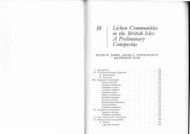You also want an ePaper? Increase the reach of your titles
YUMPU automatically turns print PDFs into web optimized ePapers that Google loves.
1.3.1 Decline <strong>of</strong> <strong>Lichens</strong><br />
Many lichen species are becoming rare, while<br />
their living area due to the activities <strong>of</strong> man is<br />
destroyed or all to frequently is subjected to<br />
change. Their slow growth, <strong>of</strong>ten also in<br />
association with the late onset <strong>of</strong> reproduction,<br />
brings about an always stronger and more<br />
frequent meshing with the onset <strong>of</strong> an ominous<br />
environment. The dwindling <strong>of</strong> the occurrence<br />
<strong>of</strong> lichens has reached a dismaying degree. In<br />
<strong>Baden</strong>-<strong>Württemberg</strong> alone, that by its richly<br />
variable landscape <strong>of</strong>fers much better conditions<br />
for the existence and the survival <strong>of</strong> lichens than<br />
many other regions <strong>of</strong> Germany, clearly over<br />
10% <strong>of</strong> the species are missing or extinct.<br />
Dozens <strong>of</strong> lichens here are immediately<br />
threatened with extinction. Many have only a<br />
few refugia where especially favorable climatic<br />
and pure air conditions as well as little<br />
disturbance make survival possible up to this<br />
time. By stopping stronger decimation <strong>of</strong> the<br />
incidence and populations is to reckon with the<br />
complete disappearance <strong>of</strong> these lichens within<br />
the next year or next two decades.<br />
Evidence for the decline is produced by old<br />
publications about the lichen flora, from others<br />
still maintaining access to collections <strong>of</strong> lichens<br />
from an earlier time. In old herbaria species are<br />
represented, which no longer exist today; many<br />
lichens extremely rare today are present from<br />
places, where they in the meantime have<br />
certainly disappeared.<br />
The reasons for the decline <strong>of</strong> lichens are<br />
many fold. The intensive land and economic<br />
utilization in the widest sense, e.g. “destoning”<br />
and fertilization <strong>of</strong> poor turf (especially in the<br />
Black Forest) and the shifting <strong>of</strong> vineyards with<br />
the destruction <strong>of</strong> the typical vineyard wall on<br />
sloping sites. The massive clearing <strong>of</strong> farm land<br />
in the severe style <strong>of</strong> the years <strong>of</strong> the sixties and<br />
seventies have led to a scarcely assessable<br />
decimation <strong>of</strong> the lichen populations. A greater<br />
loss to the occurrence <strong>of</strong> the typical bark lichen<br />
flora came about through cutting down the street<br />
trees. From topographic maps we can determine<br />
that within the past forty years at least four fifths<br />
<strong>of</strong> the rows <strong>of</strong> trees along avenues and streets<br />
were exterminated. Methods <strong>of</strong> forestry<br />
utilization have lead to considerable<br />
impoverishment and to a change in the lichen<br />
vegetation <strong>of</strong> the forest, which had the effect <strong>of</strong><br />
habitat alteration on large areas, especially clearcutting<br />
and afforestation with exotic tree species,<br />
above all conifers. The scarcity <strong>of</strong> old trees in<br />
today’s managed forests produces a very<br />
negative effect upon the species diversity. It<br />
demonstrates that near natural richly structured<br />
forests with a correspondingly high portion <strong>of</strong><br />
older trees and dead trees are especially rich in<br />
lichen species.<br />
The most important causes <strong>of</strong> lichen decline<br />
includes the air pollution by power stations,<br />
industry, domestic combustion, and traffic.<br />
<strong>Lichens</strong> react to the emissions in many ways<br />
essentially as susceptible as other organisms; the<br />
modest resistance depends likely upon their<br />
(already referred to) special constitution,<br />
particularly their symbiotic nature, the lack <strong>of</strong> an<br />
effective protective tissue and their longevity.<br />
According to our knowledge, acid producing<br />
emissions are especially devastating, on the one<br />
hand directly as toxic substances, on the other<br />
hand indirectly by acidifying rain water, that as a<br />
rule is directly taken up by the lichen thallus.<br />
Sulfur dioxide is especially injurious to lichens,<br />
as it leads to injury <strong>of</strong> fundamental metabolic<br />
processes, which arise by acidifying the water<br />
and the substrates, resulting in many lichen<br />
species being no longer supported.<br />
The impoverishment <strong>of</strong> the lichen flora is<br />
further advanced, as the increase in the burden <strong>of</strong><br />
acid emissions. Many species are especially<br />
sensitive and therefore only still occur in regions<br />
with nearly pure air. Other species disappear in<br />
the case <strong>of</strong> moderate or at first stronger<br />
concentration <strong>of</strong> harmful materials. One can<br />
correlate the reading <strong>of</strong> the lichen flora, as an<br />
approximation <strong>of</strong> the degree <strong>of</strong> the burden <strong>of</strong><br />
lichen damaging air pollution; that apparently the<br />
sulfur dioxide and the acid content <strong>of</strong> the rain<br />
water are most significant in the decimation <strong>of</strong><br />
lichens, leading to indexing the region with more<br />
or less higher burden with respect to these factors<br />
with the help <strong>of</strong> certain lichen species (Wirth<br />
1987). Numerous widespread species <strong>of</strong> barkdwelling<br />
lichen species in this book allow – by<br />
the knowledge <strong>of</strong> the ecology <strong>of</strong> these groups –<br />
the use <strong>of</strong> bio-indication <strong>of</strong> that kind <strong>of</strong> burden.<br />
Lately – as a result <strong>of</strong> decreasing sulfur<br />
dioxide emissions – a recovery has been<br />
identified in many species. The acid emissions,<br />
especially sulfur dioxide, are an especially<br />
important factor in emission caused lichen<br />
decline, but by no means the only one. Even dust<br />
and heavy metals play a role. In earlier times<br />
eutrification (fertilizing) increased air pollution<br />
and led then to extensive alteration <strong>of</strong> the lichen<br />
vegetation.<br />
6





